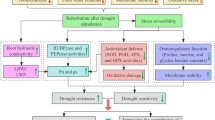Abstract
Amphistomatous C3 (Nicotiana tabacum L., Datura stramonium L.) and C4 (Sorghum saccharatum Pers. and Zea mays L.) species were examined to find how (if at all) their inherent differences in water-use economy are reflected in apparent cuticular transpiration or vice versa. Transpiration efficiency (TE) was calculated from steady state photosynthesis (A) and transpiration (E) rates estimated for the upper side of the leaf after light induction of stomata opening. Apparent cuticular transpiration (’Ec) was measured as the part of transpiration which was not eliminated by convective counteraction of the air stream passing across the amphistomatous leaf: total pressure difference (AP) across the leaf was increased and the minimal value of EΔPτ0 was taken as the apparent cuticular transpiration rate (’Ec). ’Ec was treated relative to E at AP equal to zero (EGDP=0), E’cr. Measurements were carried out under two leaf-air vapour pressure differences (VPD).
Er (i.e. EGDPτ0/EGDP=0) versus GDP patterns differed qualitatively between the investigated C3 and C4 plants. TE increased and ’Ecr decreased from tobacco, stramony, maize to sorghum for both VPD of air. ’Ecr and TE were approximately linearly related, the slope being dependent on VPD. The increase in VPD resulted in larger E and slightly smaller epidermal conductance (g) at GDP equal to zero. Both E’cr and E’cr decreased markedly at the same time especially, for species with high TE. The results were considered as an indirect confirmation that E’c values estimated by the technique used reflect species-specific differences in external peristomatal and cuticular vapour loss, at least in a relative sense.
Similar content being viewed by others
References
Appleby, R. F., Davies, W. J.: A possible evaporation site in the guard cell wall and the influence of leaf structure on the humidity response by stomata of woody plants. - Oecologia56: 30–40, 1983.
Beyschlag, W., Pfanz, H.: A fast method to detect the occurrence of nonhomogeneous distribution of stomatal aperture in heterobaric plant leaves. Experiments with Arbutus unedo L. during the diurnal course. - Oecologia82: 52–55, 1990.
Cowan, I. R., Troughton, J. H.: The relative role of stomata in transpiration and assimilation. -Planta97: 325–336, 1971.
Downton, W. J. S., Loveys, B. R., Grant, W. J. R.: Non-uniform stomatal closure induced by water stress causes putative non-stomatal inhibition of photosynthesis. - New Phytol.110: 503–509, 1988.
Maier-Maercker, U.: The role of peristomatal transpiration in the mechanism of stomatal movement. - Plant Cell Environ.6: 369–380, 1983.
Plhák, F.: Dark transpiration rate and water deficit as growth limiting factors in alfalfa plants. - Biol. Plant.26: 441–447, 1984.
Richards, R. A., Rawson, H. M., Johnson, D. A.: Glaucousness in wheat: Its development and effect on water-use efficiency, gas exchange and photosynthetic tissue temperatures. - Aust. J. Plant Physiol.13: 465–473, 1986.
Šantrůček, J., Slavik, B.: A method for separating cuticular and stomatal components of gas exchange by amphistomatous leaves. I Model solution. II Experimental solution. - J. exp. Bot.41: 795–802, 803-813, 1990a, 1990b.
Sheriff, D. W.: Epidermal transpiration and stomatal responses to humidity: Some hypotheses explored. - Plant Cell Environ.7: 669–677, 1984.
Terashima, I., Wong, S.-C., Osmond, C. B., Farquhar, G. D.: Characterisation of non-uniform photosynthesis induced by abscisic acid in leaves having different mesophyll anatomies. - Plant Cell Physiol.29: 385–394, 1988.
Author information
Authors and Affiliations
Rights and permissions
About this article
Cite this article
Šantrůček, J. Transpiration efficiency and apparent cuticular transpiration in some c3 and c4 plants. Biol Plant 33, 192–199 (1991). https://doi.org/10.1007/BF02897880
Received:
Accepted:
Issue Date:
DOI: https://doi.org/10.1007/BF02897880




